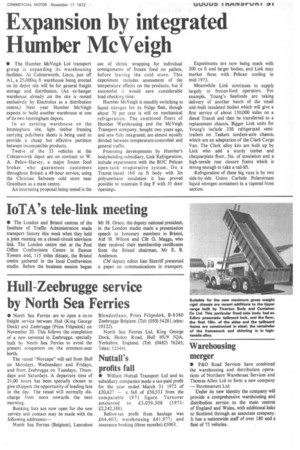Expansion by integrated Humber McVeigh
Page 57

If you've noticed an error in this article please click here to report it so we can fix it.
• The Humber McVeigh Ltd transport group is expanding its warehousing facilities. At Colsterworth, Lines, just off Al, a 25,000sq ft warehouse being erected on its depot site will be for general freight storage and distribution. (An ex-hanger warehouse already on the site is rented exclusively by Electrolux as a distribution centre.) Next year Humber McVeigh expects to build another warehouse at one of its two Immingham depots.
In an existing warehouse on the Immingham site, light timber framing carrying polythene sheets is being used to provide a cheap but effective partition between incompatible products.
Twelve of the 33 vehicles at the Colsterworth depot are on contract to W. A. Pellew-Harvey, a major frozen food broker who guarantees customers throughout Britain a 48-hour service, using the Christian Salvesen cold store near Grantham as a main centre.
An interesting proposal being tested is the use of shrink wrapping for individual consignments of frozen food on pallets, before leaving the cold store. This experiment includes assessment of the temperature effects on the products, but if successful it would save considerable load-checking time.
Humber McVeigh is steadily switching to liquid nitrogen for its fridge fleet, though about 70 per cent is still on mechanical refrigeration. The combined fleets of Humber Warehousing and the' McVeigh Transport company, bought two years ago, and now fully integrated, are almost equally divided between temperature-controlled and general traffic.
Promising developments by Humber's bodybuilding subsidiary, Link Refrigeration, include experiments with the BOC Pelican open-tank evaporative system. On a Transit-based 160 cu ft body with 3in polyurethane insulation it has proved possible to maintain 0 deg F with 35 door openings. Experiments are now being made with 200 cu ft and larger bodies, and Link may market these with Pelican cooling in mid-1973.
Meanwhile Link continues to supply largely to frozen-food operators. For example, Young's Seafoods are taking delivery of another batch of the small unit-built insulated bodies which will give a first service of about 150,000 miles on a diesel Transit and then be transferred to a replacement chassis. Bigger Link units for Young's include 33ft refrigerated semitrailers on Taskers tandem-axle chassis, which are an adaptation of the Clark Cargo Van. The Clark alloy kits are built up by Link who add a sturdy timber and cbequerplate floor, 5in. of insulation and a high-tensile rear closure frame which is strong enough to take a tail-lift.
Refrigeration of these big vans is by two side-by-side Union Carbide Polarstream liquid nitrogen containers in a tapered front section.
































































































































































